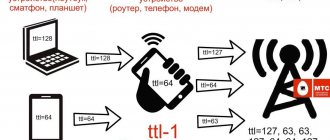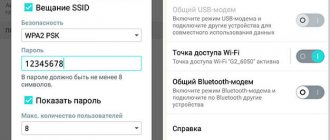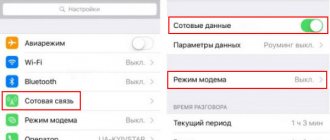Today, many subscribers are wondering how to get around the “Unlimited” restriction from MTS on Internet distribution. After all, before the new rules that came into force this year, it was possible to distribute traffic for free. Can this be done now, and what methods are available for this?
Initially, the MTS operator introduced the new “Unlimited” tariff as a tariff with the ability to distribute traffic for free. On the SIM card, when installed, distributing Wi-Fi to other devices was possible without any restrictions. In November 2021, MTS announced that from now on, for every 100 MB of distribution, the subscriber will have to pay 30 rubles.
Users did not like the idea of paying for Internet distribution. Increasingly, they are beginning to wonder how to avoid paying for Internet distribution. Various forums have already presented entire schemes on how to bypass the restrictions and, of course, avoid unpleasant consequences on the part of the communication provider.
Scandalous marketing of MTS
Most subscribers were not ready for such an innovation as an unprofitable daily tariff for Internet from MTS. Neither a wide advertising campaign nor other events helped retain the target audience.
For this reason, MTS has lost many of its regular customers who abandoned the Unlimited tariff.
To justify MTS, an argument can be made that the price is 30 rubles. per day is quite acceptable, considering the prices for similar services of other Russian operators. But the injustice lies in the fact that they set their tariffs for Internet distribution from the very beginning, and their conditions were transparent.
In the case of MTS, there was a marketing plan, which, as practice has shown, played a bad joke on its developers. Finding workarounds for subscribers is the only way to use the Internet under the conditions that were initially announced by MTS, that is, for free.
Basics
One of the operator’s main checks to determine distribution is checking the TTL (time-to-live) parameter. Both in Tariffische and in Unlimited they also did this check based on this number. And as soon as anything diverges, it is immediately prohibited. I'll try to briefly explain what it is:
- TTL – number.
- The TTL decreases by 1 each time a network packet passes through a node (phone, router, provider router, etc. up to the site).
- TTL is designed to limit the endless search for a target on the network (for example, if it is set to 32, then no more than 32 route points can be used to search for the final site, and if exceeded, the connection is reset).
- Using the TTL at the intermediate node, the number of points passed can be calculated.
In summary, the operator can check the TTL on their routers and understand from the discrepancy in the standard number that there is a distribution via Wi-Fi. One of our options for bypassing the ban is to change the TTL parameter yourself on devices that are connected to the distribution phone. This can be done on both smartphones and laptops. We will try!
For easy reference, I also offer video instructions:
Important information for MTS Unlimited subscribers
Before considering ways to level the restrictions on Internet distribution Unlimited, you need to take note of the following. Sharing the Internet with the device is prevented by the operator’s control, which he exercises via TTL.
In this way, the operator instantly calculates the location where the traffic is made unauthorized.
Next, you will learn about how TTL works, because without this basic information it is impossible to proceed further.
TTL operates as follows:
- It is given its own value by all devices that are taken into account at the time the operator sends a package of services.
- With TTL, the packet passes through a special router. As a result, its value is reduced by 1. For example, if we take the standard value for mobile devices, which is 64 units, during the transition it will decrease to 63.
- The decrease in value is monitored by the operator, which allows him to quickly respond to the fact of distribution without his permission.
What you need to know
If you look at it sensibly, MTS acted dishonestly towards its subscribers. Why not reciprocate, because what difference does it make where users spend their traffic?
To control Wi-Fi distribution, telecom operators use TTL (stands for “Time to live”). It's difficult to explain what it is. Let's consider only the principle of operation:
- All devices set their own TTL value, which is taken into account when sending data packets to the network.
- The packet passes through the router and then decrements its value by one. For example, from 64 (the standard value used by mobile devices) to 63.
- The carrier monitors this and knows when the Wi-Fi goes live.
Next, we will consider both methods in detail.
How to distribute Internet on MTS Unlimited effectively?
For a long time, specialists have been testing various methods that make it possible to change TTL, but practice has shown that not all of them are suitable for subscribers.
Basically, after restarting the device, the TTL value returns to its original value. Therefore, the priority task remains to find a method for recording the value. This will allow the method to be much more effective when working with the device, and the subscriber, in turn, will not have the need to return to this problem again and again.
How to distribute Internet traffic and not pay for it? Special applications TTL Editor, TTLFixer or TTL Master will help with this. Their advantage is ease of use and high efficiency of the work done. Their nuance is that after each restart of the device, the application program will need to be activated and the TTL updated.
To start using one of these applications, you just need to download and activate it.
Due to the simplicity of these actions, instructions are not needed.
How to distribute Wi-Fi from MTS Unlimited for free from various devices?
Distribution of MTS Unlimited Internet for free can be carried out through two main sources. This can be done both from a computer and from an Android mobile device. Each method has its own specifics, which will be discussed below.
The first method is suitable for those who find it easier and more accessible to operate from their own computer. At the initial stage, you will have to make a partial correction of the registration data.
- Sign in to the registry. In the menu, select the “Run” function, while simultaneously pressing win + r, writing “regedit” in the input field.
- Find the settings you need. They look like "HKEY_LOCAL_MACHINE\SYSTEM\CurrentControlSet\Services\Tcpip\Parameters".
- Go to the Parameters tab, where you will find the “Create” item.
- Select "DWORD" and assign the name "DefaultTTL".
- Place a check mark next to the decimal number system.
- Set TTL and set it to 65.
- Save the settings and reboot the system.
Adjusting TTL on a computer
This method is suitable for those who transfer Wi-Fi exclusively to a computer. You will have to slightly adjust the registry data.
Instructions for Windows 32 bit:
- You need to enter the registry. Call up the “Run” menu by pressing “win” + “r” at the same time. Write “regedit” in the input field.
- Let's go to the necessary settings - “HKEY_LOCAL_MACHINESYSTEMCurrentControlSetServicesTcpipParameters”.
- Click on the “Parameters” tab. Next, look for the “Create” item.
- Select "DWORD". Be sure to assign a name - “DefaultTTL”.
- Check the box next to the decimal number system.
- All that remains is to set the TTL. Remember that when passing through a router, it increases by one point. Set the value to “65”.
- Save. Reboot the system.
The instructions for Windows 64 bit are practically the same. We go to the registry and follow the specified path. The only difference is that instead of “DWORD” we create “QWORD”. Don't forget to restart your computer.
To verify that the action performed correctly, do the following:
- We distribute Wi-Fi using a mobile device. We connect to the network from a computer.
- Go to the “Network and Sharing Center”. Next, select the network you are using and view its properties. In the “Default Gateway” item we find out the IP and write it down.
- Call the “Run” program using the “win” + “R” buttons. Enter “cmd” into it.
- The command line opened. Enter the request - “ping + recorded IP” (be sure to leave spaces). Then press “Enter”.
- If TTL=64, then everything is correct.
If you don’t want to get into your computer’s connections, then enter “ping 127.0.0.1” in CMD. When using this IP, TTL=65.
As you can see, bypassing restrictions is profitable and simple.
Second way
The second way to bypass the ban on wi-fi distribution on MTS Unlimited allows you to make your phone a source for all the devices you need for free. This is possible provided you have ROOT rights. To get them, do the following:
- Download the King ROOT application to your phone.
- Install ARK and launch the application.
- Click on the green button.
Obtaining ROOT rights may not be possible. This is affected by the mobile phone model and its firmware. If you fail, try again using the applications: “SuperSU”, “FramaRoot”, “Root360”. Remember, by obtaining rights of this type, the user is at risk, since he is deprived of any guarantees for his own device. TTL adjustment from an Android mobile device occurs according to the following algorithm:
- Download a special program called “TTL Master” to your device.
- Install the downloaded application and launch it.
- Find a circle with numbers on the interface where the indicator 63 is located.
- Go to settings
- Correct the TTL value to 64.
- Save.
- Return to the main page and select the “Bypass restrictions” command.
- Reboot your smartphone or send it to “Flight”, and after a minute return it to normal mode.
If all actions were performed correctly, you will not receive messages from the MTS operator with appropriate warnings or notifications of violations.
Adjusting TTL on an Android device
This method allows you to make sure that your phone can transmit Wi-Fi to absolutely any device for free.
To succeed, you need to get ROOT rights on Android. This is done as follows:
- Download the “King ROOT” application. It cannot be found on Google Play.
- Install the APK. Let's launch the application.
- A large green button will appear, click on it.
Unfortunately, not everyone will be able to obtain ROOT rights. It depends on your phone model and its firmware. If this does not help, use other applications: “SuperSU”, “FramaRoot”, “Root360”.
Let's move on to the next part of the instructions:
- Download the TTL Master program. It is easily found on Google Play. But it’s better to find another version using a search engine - 3.0.1.
- Install and launch the application.
- We see the interface on which there is a circle with numbers. The value indicated there is “63”.
- Go to settings using the corresponding icon.
- Change the “TTL value” and “TTL value in the input field”. You must specify that the TTL is 64.
- Save the settings.
- Let's return to the main program interface. Click on the “Bypass restrictions” button.
Next, we make sure that the phone uses the “In Flight” mode. After a few seconds, we return the device to its normal operating mode. Without this, nothing will work.
Now you can distribute Wi-Fi without spending any money.
Is the Internet distributed free of charge on the MTS Unlimited tariff? This can be checked using the method indicated in the instructions for the computer. And also you should not receive messages from MTS.
Operators do not have to control how users use traffic. Therefore, above are instructions that will help save your money. It is suitable not only for MTS, but also for other cellular operators.
Add a comment Cancel reply
For questions regarding cooperation, please contact [email protected]
Abakan, Almetyevsk, Angarsk, Arzamas, Armavir, Artyom, Arkhangelsk, Astrakhan, Achinsk, Balakovo, Balashikha, Barnaul, Bataysk, Belgorod, Berdsk, Berezniki, Biysk, Blagoveshchensk, Bratsk, Bryansk, Veliky Novgorod, Vladivostok, Vladikavkaz, Vladimir, Volgograd , Volgodonsk, Volzhsky, Vologda, Voronezh, Grozny, Derbent, Dzerzhinsk, Dimitrovgrad, Domodedovo, Evpatoria, Ekaterinburg, Yelets, Essentuki, Zheleznodorozhny, Zhukovsky, Zlatoust, Ivanovo, Izhevsk, Irkutsk, Yoshkar-Ola, Kazan, Kaliningrad, Kaluga, Kamensk -Uralsky, Kamyshin, Kaspiysk, Kemerovo, Kerch, Kirov, Kislovodsk, Kovrov, Kolomna, Komsomolsk-on-Amur, Kopeisk, Korolev, Kostroma, Krasnogorsk, Krasnodar, Krasnoyarsk, Kurgan, Kursk, Kyzyl, Lipetsk, Lyubertsy, Magnitogorsk, Maykop , Makhachkala, Miass, Moscow, Murmansk, Murom, Mytishchi, Naberezhnye Chelny, Nazran, Nalchik, Nakhodka, Nevinnomyssk, Neftekamsk, Nefteyugansk, Nizhnevartovsk, Nizhnekamsk, Nizhny Novgorod, Nizhny Tagil, Novokuznetsk, Novokuibyshevsk, Novomoskovsk, Novorossiysk, Novosibirsk, Novoche Boksarsk, Novocherkassk, Novoshakhtinsk, Novy Urengoy, Noginsk, Norilsk, Noyabrsk, Obninsk, Odintsovo, Oktyabrsky, Omsk, Orel, Orenburg, Orekhovo-Zuevo, Orsk, Penza, Pervouralsk, Perm, Petrozavodsk, Petropavlovsk-Kamchatsky, Podolsk, Prokopyevsk, Pskov, Pushkino , Pyatigorsk, Ramenskoye, Rostov-on-Don, Rubtsovsk, Rybinsk, Ryazan, Salavat, Samara, St. Petersburg, Saransk, Saratov, Sevastopol, Severodvinsk, Seversk, Sergiev Posad, Serpukhov, Simferopol, Smolensk, Sochi, Stavropol, Stary Oskol , Sterlitamak, Surgut, Syzran, Syktyvkar, Taganrog, Tambov, Tver, Togliatti, Tomsk, Tula, Tyumen, Ulan-Ude, Ulyanovsk, Ussuriysk, Ufa, Khabarovsk, Khasavyurt, Khimki, Cheboksary, Chelyabinsk, Cherepovets, Cherkessk, Chita, Shakhty , Shchelkovo, Elektrostal, Elista, Engels, Yuzhno-Sakhalinsk, Yakutsk, Yaroslavl.
Hello! After the holidays, I went to sort out issues at the post office and found an interesting message about the distribution of MTS Internet. I had to deal with this before, but this is quite interesting. People signed up for the “Smart Unlimited” tariff, which included as much as 10 GB of mobile traffic.
It’s clear that during the holidays you need to share everything, including the Internet, but MTS has introduced restrictions - to distribute Wi-Fi you need to pay 30 rubles a day (but you want it for free), and this is already higher than the price of the tariff itself, and any home Internet will cost less. However, such options were not included in the original conditions. MTS in Bezlimitishche changed horses at the crossing, and people either left or began to look for workarounds in search of their cheap unlimited Internet (although unlimitedness at such a price can still be argued). In this article I would like to show how the operator calculates the distribution of the Internet, and how you can bypass this ban without overpaying. Begin!
Perform actions at your own peril and risk! Our portal WiFiGid.ru does not encourage illegal actions; any information is provided for educational purposes in the field of information technology. The operator can change its verification algorithms at any time.











